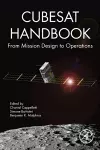
CubeSat Handbook
3 contributors - Paperback
£157.00
Dr. Chantal Cappelletti is currently an Assistant Professor at University of Nottingham, where she is affiliated with the Nottingham Geospatial Institute and Gas Turbine & Transmissions Research Centre. Previously, she was an Assistant Professor at the University of Brasilia (Brazil) and a visiting researcher at Morehead State University (USA). She is an active member of the International Academy of Astronautics and chairwoman of the IAA Latin American CubeSat workshop. She is a co-founder of the Italian company GAUSS Srl, whose main business is small satellite components and launch providers. As CEO of the company, she procured the launch of several satellites from different countries and the first PocketQubeSat launch ever. She has led 6 satellite projects involving students from different countries and universities. Her activities focus mainly on small satellites and educational programs, with specific interests also on Space Debris and Biomedical research in space. Recently she established the UoN CubeSat program, involving students from different disciplines and faculties. Currently, Dr Chantal and her team are working on 4 satellite projects (leading on two of these), and has several international collaborations in Europe, Brazil, Russia and United States. She is authors of more than 50 publications and co-editor of the "CubeSat Handbook: from mission analysis to operation Simone Battistini received his BSc (2006) and MSc (2009) degrees in Control System Engineering and a PhD in Aerospace Engineering from Sapienza Università di Roma (Italy). Dr Battistini is a Senior Lecturer in Aerospace Engineering at Sheffield Hallam University (UK). He has been working in the field of Aerospace Engineering both at academic and industrial level, having served on the faculty of the University of Brasília (Brazil) and on the staff of MBDA Italy. In 2017 he was a visiting professor at the University of Vigo (Spain). He was the principal or co-principal investigator on 4 projects concerning aerospace systems funded by Brazilian public institutions. His main research interests are related to guidance, navigation and control of aerospace systems. Dr. Benjamin K. Malphrus is Professor of Space Science at Morehead State University where he also directs the University’s Space Science Center. He served as project director of the design and construction of the 13 M Morehead Radio Telescope and more recently the 21 M Space Tracking Antenna operated by the center. He has served on the scientific staff of the National Radio Astronomy Observatory, as visiting scientist at NASA’s Wallops Flight Facility and on the faculty of universities including the University of South Carolina and West Virginia University. He is author of a book on the evolution of instrumentation in radio astronomy. He has initiated and participated in numerous educational initiatives including the development of space science and astrophysics degree programs at Morehead State University. Dr. Malphrus has served as Principal Investigator on several nanosatellite missions including KySat-1, KySat-2, the Cosmic X-Ray Background Nanosatellite (CXBN), CXBN-2, TechSat-1, DM-7, and Lunar IceCube, and has had various roles on other microsatellite missions. Seven of these satellite missions have flown in space to date. He currently leads an effort (supported by NASA’s Advanced Exploration Systems) to upgrade the 21 meter ground station at Morehead State to become the NASA Deep Space Network node for interplanetary smallsats. He and his team was awarded a $24million program by NASA in 2016 to develop and send a space probe (Lunar IceCube) to the Moon to investigate the transport physics of lunar volatiles including water ice. Lunar IceCube will launch on the maiden voyage of NASA’s newest rocket- the Space Launch System, that, when it launches in 2020, will be the largest rocket launched in the history of the space program. Dr. Malphrus has published papers in scientific journals on topics ranging from extragalactic astrophysics to instrumentation in radio astronomy, to space systems engineering. He has managed over 100 grant projects totaling over $34 million and negotiated transfers and gifts of scientific equipment to the university totaling over $7 million. In 1994, 1995, and 1996 Dr. Malphrus was awarded the NASA JOVE research fellowship for research in the structure and kinematics of gravitationally interacting galaxies. This research led to the discovery of the first genuinely young galaxy ever observed in an interacting field, NGC 5291-B. Recently, Dr. Malphrus has been involved in promoting, capitalizing, designing, and constructing a $15.6 million state-of-the-art research, development, and education center for the space science program. In the late 1990s, Dr. Malphrus developed a theory of galaxy formation that has gained wide acceptance among the astronomical community.